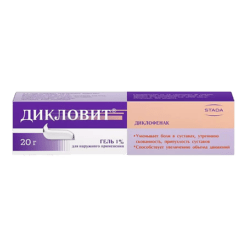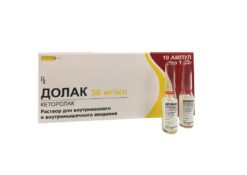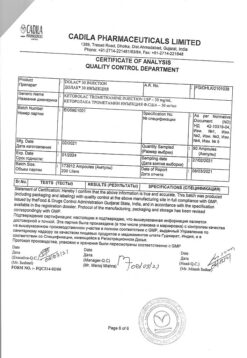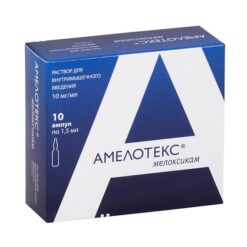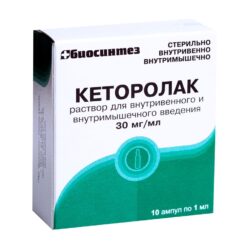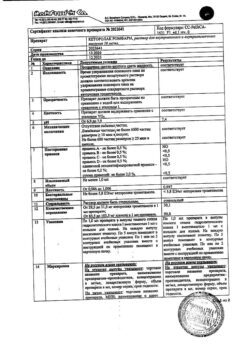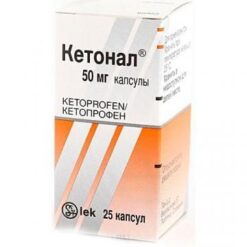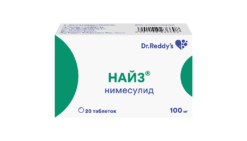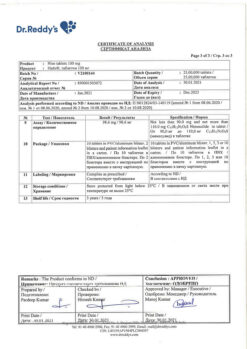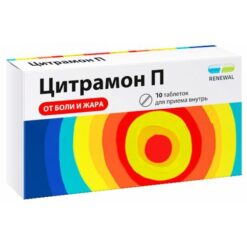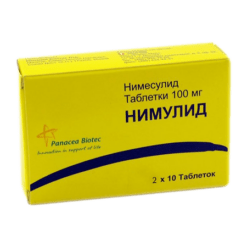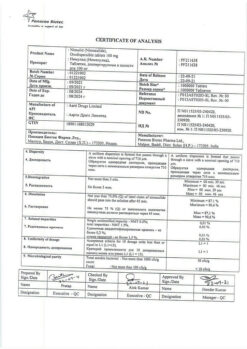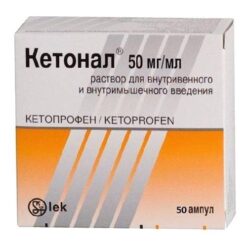No products in the cart.
Diklovit, rectal 50 mg 10 pcs.
€7.56 €6.62
Description
Diclofenac has anti-inflammatory, analgesic and antipyretic effects.
Inhibiting cyclooxygenase 1 and 2 indiscriminately, it disrupts arachidonic acid metabolism, reduces the amount of prostaglandins in the focus of inflammation.
In rheumatic diseases the anti-inflammatory and analgesic effect of diclofenac significantly reduces the severity of pain, morning stiffness and joint swelling, which improves the functional state of the joint.
In case of injury and in the postoperative period diclofenac reduces pain and inflammatory swelling.
In primary algodysmenorrhea, it relieves pain and bleeding.
The maximum plasma concentration is established after 30-40 minutes and is in a linear relationship to the dose used.
There are no changes in the pharmacokinetics of diclofenac on repeated administration; it does not cumulate.
The binding to plasma proteins is more than 99% (most of it binds with albumin).
It penetrates into the synovial fluid. Maximum concentration in synovial fluid is observed 2-4 hours later than in plasma.
The half-life of synovial fluid is H-b (the concentration of the active substance in synovial fluid is higher than in plasma 4-6 hours after administration and stays higher for 12 hours).
The relationship between the concentration of the drug in synovial fluid and the clinical efficacy of the drug has not been elucidated.
Metabolism: 50% of the active substance is metabolized during “first passage” through the liver.
Metabolism occurs as a result of multiple or single hydroxylation and conjugation with glucuronic acid.
The enzyme system P450 CYP2C9 is involved in metabolism of the drug. The pharmacological activity of the metabolites is lower than that of diclofenac.
The plasma elimination half-life is 2 hours. 65% of the administered dose is excreted as metabolites by the kidneys; less than 1% is excreted unchanged, the rest of the dose is excreted as metabolites in the bile.
In patients with severe renal insufficiency (creatinine clearance less than 10 ml/min) excretion of metabolites in bile is increased, while there is no increase of their concentrations in blood.
In patients with chronic hepatitis or compensated liver cirrhosis pharmacokinetic parameters of diclofenac are not changed.
Diclofenac penetrates into breast milk.
Indications
Indications
Diseases of the musculoskeletal system (rheumatoid arthritis, psoriatic, juvenile chronic arthritis, ankylosing spondylitis; gouty arthritis, rheumatic soft tissue disease,
osteoarthritis of peripheral joints and spine, including with radicular syndrome, tenosynovitis, bursitis).
Pain syndrome of mild or moderate severity: neuralgia, myalgia, lumboischialgia, post-traumatic pain syndrome accompanied by inflammation, postoperative pain, headache, migraine, algomenorrhea, adnexitis, toothache.
As part of complex therapy for infectious and inflammatory diseases of the ear, nose and throat with severe pain (pharyngitis, tonsillitis, otitis).
Pharmacological effect
Pharmacological effect
Diclofenac has anti-inflammatory, analgesic and antipyretic effects.
By indiscriminately inhibiting cyclooxygenase 1 and 2, it disrupts the metabolism of arachidonic acid and reduces the amount of prostaglandins at the site of inflammation.
In rheumatic diseases, the anti-inflammatory and analgesic effect of diclofenac helps to significantly reduce the severity of pain, morning stiffness, and swelling of the joints, which improves the functional state of the joint.
For injuries, in the postoperative period, diclofenac reduces pain and inflammatory swelling.
In primary algodismenorrhea, it relieves pain and bleeding.
The maximum concentration in the blood plasma is achieved after 30–40 minutes and is linearly dependent on the dose used.
No changes in the pharmacokinetics of diclofenac are observed during repeated administration and do not accumulate.
Communication with plasma proteins is more than 99% (most of it is associated with albumin).
Penetrates into synovial fluid. The maximum concentration in synovial fluid is observed 2–4 hours later than in plasma.
The half-life from the synovial fluid is 3-6 hours (the concentration of the active substance in the synovial fluid 4-6 hours after administration of the drug is higher than in plasma, and remains higher for another 12 hours).
The relationship between the concentration of the drug in the synovial fluid and the clinical effectiveness of the drug has not been clarified.
Metabolism: 50% of the active substance is metabolized during the “first pass” through the liver.
Metabolism occurs as a result of multiple or single hydroxylation and conjugation with glucuronic acid.
The enzyme system P450 CYP2C9 takes part in the metabolism of the drug. The pharmacological activity of the metabolites is lower than that of diclofenac.
The half-life from plasma is 2 hours. 65% of the administered dose is excreted in the form of metabolites by the kidneys; less than 1% is excreted unchanged, the rest of the dose is excreted as metabolites in the bile.
In patients with severe renal failure (creatinine clearance less than 10 ml/min), the excretion of metabolites in bile increases, but no increase in their concentration in the blood is observed.
In patients with chronic hepatitis or compensated liver cirrhosis, the pharmacokinetic parameters of diclofenac do not change.
Diclofenac passes into breast milk.
Special instructions
Special instructions
Patients taking the drug must refrain from activities that require increased attention and rapid mental and motor reactions, and alcohol consumption.
Active ingredient
Active ingredient
Diclofenac
Composition
Composition
One suppository contains:
Active ingredient – diclofenac sodium – 50 mg;
The basis for suppositories is solid fat (Vitepsol brand N 15, W 35, Supposir brand NA 15, NAS 50) – until a suppository weighing 1.26 g is obtained.
Contraindications
Contraindications
Hypersensitivity (including to other NSAIDs), erosive and ulcerative lesions of the gastrointestinal tract (in the acute phase), bleeding from the gastrointestinal tract, “aspirin” asthma, hematopoietic disorders,
hemostasis disorders (including hemophilia), pregnancy, childhood (up to 15 years), lactation, rectal bleeding, hemorrhoids, trauma or inflammation of the rectum.
With caution
Anemia, bronchial asthma, congestive heart failure, arterial hypertension, coronary heart disease, edema syndrome, liver or kidney failure, alcoholism, inflammatory diseases
intestinal diseases, erosive and ulcerative diseases of the gastrointestinal tract without exacerbation, diabetes mellitus, condition after extensive surgical interventions, inducible porphyria, old age, diverticulitis, systemic connective tissue diseases.
Side Effects
Side Effects
The side effects that occur depend on individual sensitivity, the dose used and the duration of treatment.
The term “sometimes” is used if side effects occur in 1–10% of patients, “rarely” – in 0.001–1% of patients.
Gastrointestinal tract:
Sometimes – abdominal pain, a feeling of bloating, diarrhea, nausea, constipation, flatulence, increased levels of liver enzymes, peptic ulcer with possible complications (bleeding, perforation), gastrointestinal bleeding;
Rarely – vomiting, jaundice, melena, blood in the stool, damage to the esophagus, aphthous stomatitis, dry mouth and mucous membranes, hepatitis (possibly fulminant), liver necrosis, cirrhosis, hepatorenal syndrome, changes in appetite, pancreatitis, cholecystopancreatitis, colitis.
Nervous system:
Sometimes – headache, dizziness;
Rarely – sleep disturbance, drowsiness, depression, irritability, aseptic meningitis (more often in patients with systemic lupus erythematosus and other systemic connective tissue diseases), convulsions, weakness, disorientation, nightmares, a feeling of fear.
Sense organs:
Sometimes – tinnitus;
Rarely – blurred vision, diplopia, taste disturbance, reversible or irreversible hearing loss, scotoma.
Skin:
Sometimes – skin itching, skin rash;
Rarely – alopecia, urticaria, eczema, toxic dermatitis, exudative erythema multiforme, incl. Stevens-Johnson syndrome, toxic epidermal necrolysis (Lyell’s syndrome), increased photosensitivity, pinpoint hemorrhages.
Genitourinary system:
Sometimes – fluid retention;
Rarely – nephrotic syndrome, proteinuria, oliguria, hematuria, interstitial nephritis, papillary necrosis, acute renal failure, azotemia.
Hematopoietic organs and immune system:
Sometimes – anemia (including hemolytic and aplastic anemia), leukopenia, thrombocytopenia, eosinophilia, agranulocytosis, thrombocytopenic purpura, worsening of infectious processes (development of necrotizing fasciitis).
Respiratory system:
Rarely – cough, bronchospasm, laryngeal edema, pneumonitis.
Cardiovascular system:
Rarely – increased blood pressure; congestive heart failure, extrasystole, chest pain.
Allergic reactions:
Rarely – anaphylactoid reactions, anaphylactic shock (usually develops rapidly), swelling of the lips and tongue, allergic vasculitis.
Local reactions after rectal use:
Rarely – irritation of the rectal mucosa, mucous discharge mixed with blood, pain during bowel movements, rectal bleeding.
Interaction
Interaction
Increases plasma concentrations of digoxin, methotrexate, lithium and cyclosporine.
Reduces the effect of diuretics; against the background of potassium-sparing diuretics, the risk of hyperkalemia increases; against the background of anticoagulants, thrombolytic agents (alteplase, streptokinase, urokinase) – the risk of bleeding (usually from the gastrointestinal tract).
Reduces the effects of antihypertensive and hypnotic drugs.
Increases the likelihood of side effects of other nonsteroidal anti-inflammatory drugs and glucocorticosteroids (bleeding in the gastrointestinal tract), the toxicity of methotrexate and the nephrotoxicity of cyclosporine.
Acetylsalicylic acid reduces the concentration of diclofenac in the blood.
Concomitant use with paracetamol increases the risk of developing nephrotoxic effects of diclofenac.
Reduces the effect of hypoglycemic drugs.
Cefamandole, cefoperazone, cefotetan, valproic acid and plicamycin increase the incidence of hypoprothrombinemia.
Cyclosporine and gold preparations increase the effect of diclofenac on the synthesis of prostaglandins in the kidneys, which increases nephrotoxicity.
Simultaneous administration with ethanol, colchicine, corticotropin and St. John’s wort preparations increases the risk of bleeding in the gastrointestinal tract.
Diclofenac enhances the effect of drugs that cause photosensitivity.
Drugs that block tubular secretion increase the plasma concentration of diclofenac, thereby increasing its toxicity.
Overdose
Overdose
Symptoms: dizziness, headache, rapid breathing, clouding of consciousness, in children – myoclonic convulsions, nausea, vomiting, abdominal pain, bleeding, impaired liver and kidney function.
Treatment: activated carbon, symptomatic therapy. Forced diuresis and hemodialysis are ineffective.
Storage conditions
Storage conditions
At a temperature not exceeding 25 °C.
Keep out of the reach of children.
Shelf life
Shelf life
3 years. Do not use the drug after the expiration date.
Manufacturer
Manufacturer
Nizhpharm JSC, Russia
Additional information
| Shelf life | 3 years. Do not use the drug after the expiration date. |
|---|---|
| Conditions of storage | At a temperature not exceeding 25 ° C. Keep out of reach of children. |
| Manufacturer | Nizhpharm AO, Russia |
| Medication form | rectal suppositories |
| Brand | Nizhpharm AO |
Other forms…
Related products
Buy Diklovit, rectal 50 mg 10 pcs. with delivery to USA, UK, Europe and over 120 other countries.


